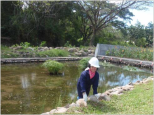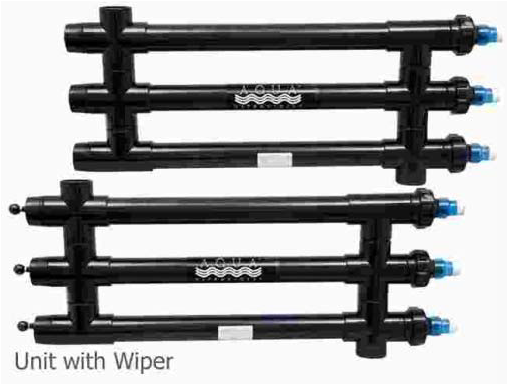Practitioner's Tool / UV Light (Natural Disinfection)
Ultraviolet (UV) light is composed of high-energy rays that are found in the natural spectrum of sunlight and can also be emitted by certain specially designed lamps and bulbs. The energy in UV light is powerful enough to kill bacteria in water or filtered effluent. Ongoing research shows that UV light could be good at killing other organisms such as helminthes and cyst-forming protists. Following are two common applications used to harness this powerful method of wastewater disinfection:
Maturation Ponds: Maturation ponds are often used as the final stage in constructed wetlands or sewage lagoons. Also called aerobic ponds, they are shallow in depth and typically not more than 1.3 meters deep, which allows the sunlight to penetrate through the entire water column. During the recommended minimum retention time of three days, the UV rays in the sunlight kill the bacteria and neutralize virus particles. Maturation ponds can be used after the majority of the suspended solids and organic matter have been removed through secondary treatment. Too much organic matter present in the effluent can generate odors. Too many residual solids may shield the bacteria from the UV light, resulting in only partial disinfection.
In order to work effectively, maturation ponds must be cleared of algae or plant matter. As sown in the image to the right, daily raking of algae may be required; however, since algae is a rich source of protein in animal feeds and as a compost additive, the recycling potential is high. If space is available and labor inexpensive, maturation ponds may be a good option for disinfection for your onsite wastewater system project.
NOTE: Using passive maturation ponds for disinfection may produce variable results. Seasonal variation in sunlight, algal blooms, and the concentration of suspended solids in the effluent flowing into the pond are all factors that may influence results.
Manufactured UV Light Generators: A number of manufacturers produce electrical UV disinfection devices for the market. These are more expensive than chlorinators but remove the daily operation and maintenance requirements. Long-term operation may cost less than other disinfection technologies depending upon local electricity costs.
In the UV disinfection device for onsite wastewater systems pictured to the left, the UV bulbs are inside the black tubes. Treated and filtered effluent flows around the light source and is disinfected. When using this type of device, keep the housing clean and address corrosion issues quickly for best light transmission.
NOTE: These products are only effective if secondary treatment and tertiary filtration devices are functioning properly. In alkaline effluent, scale formation may limit the effectiveness of this technology as deposits can interfere with UV light transmission. For more information and product description, visit pondworksetc.com.


